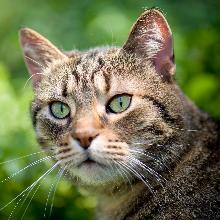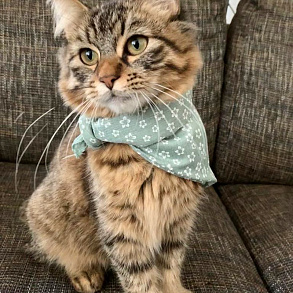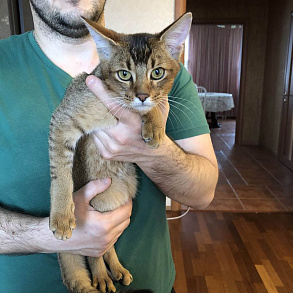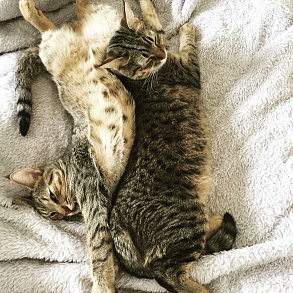Pixiebob

Pixiebob pleases even sophisticated animal lovers. Who doesn't want to make friends with a real lynx, only domestic and affectionate? Short-tailed creatures with a spotted "fur coat" are at your service!
Brief information
- Breed name: Pixiebob
- Country of Origin: USA
- Birth time of the breed: 1986
- Weight: 4 – 7 kg
- Life expectancy: 12 – 15 years
Highlights
- Pixiebob is one of the few breeds that bears a resemblance to wild cats.
- These animals show amazing delicacy and sensitivity, which makes them versatile pets.
- Representatives of the breed are quite "hospitable", calmly treat the presence of strangers in the house.
- Cats get along well with children, show a particularly reverent attitude towards kids.
- Pixybobs are suitable for keeping with other pets, with the exception of rodents and birds.
- Animals will not put up with the constant absence of the owner: this is a very sociable breed.
- Cats are famous for their intelligence and training abilities, they learn even complex commands.
- Pixybobs love active games and walks, which remind them of dogs.
- Pixiebob will not cause trouble even for those who get a cat for the first time.
Pixiebob is an American breed with a controversial history. Her main advantages are a gentle disposition, devotion and a developed intellect. Cats will not accept the role of decorative objects: they like active games, walks and maximum participation in the life of the owner. At the same time, pixibobs are very tactful and do not bother until they are called by name. And so: the animal is right there, ready to please you with purring and funny antics!
Breed characteristics
History of the pixiebob breed
The origin of short-tailed cats has created more than one intriguing theory. The most popular attributed the pixiebobs kinship with wild lynxes. In fact, the breed appeared completely by accident, but not without the intervention of the breeder Carol Ann Brewer.
In the XX century, breeders wanted to breed cats that would become reduced copies of red lynxes – the indigenous inhabitants of North America. Genotypes of mongrel domestic cats and short-tailed forest cats were used as the material. The development of such a breed in natural conditions was impossible: males in the first and second generations were most often born sterile. Nevertheless, the territory of the USA and Canada was inhabited by hundreds of such hybrids, among which there were also curious specimens.
Miss Brewer became the owner of one of them. In 1985, a woman was vacationing in the west of the continent, at the foot of the Rocky Mountains. As a souvenir, she brought a kitten bought from a married couple. They claimed that the fluffy baby appeared as a result of the union of an ordinary cat and a wild short-tailed cat. A year later, in January, the breeder sheltered another pet. It turned out to be a large cat with a short but large tail. The weight of the animal reached 8 kg, despite its exhaustion, and the crown was at knee level. The woman gave him the nickname Keba.
In April of the same year, the short-tailed Don Juan became a father: Maggie's cat got spotted offspring. Carol Brewer kept one baby and gave her the nickname Pixie. The American breeder realized that she could recreate a new breed with a specific appearance, and began to develop a breeding program. Its participants were 23 short-tailed cats caught in the Rocky Mountains, and a beautiful Pixie. To indirectly designate their offspring, Brewer introduced the term "legendary cat" and registered the copyright to the program. Carol's developments were joined by other American breeders who worked with wild cats to create an extensive genetic base and, as a result, the development of the future breed.
The first pixiebob standard appeared in 1989. The breed owed its name to Brewer's favorite. Four years later, the breeder applied to the International Cat Association (TICA), wanting to achieve official recognition of the breed. In 1994, it was registered as experimental. A year later, pixybobs were assigned to a number of new breeds and thus provided the opportunity to participate in championships and exhibitions on an equal basis with other cats. A short-tailed handsome man named Zeus was even awarded an international prize.
Although representatives of TICA have included pixybobs in the official register, not all feline associations have recognized these cats. The main reasons for refusal are the presence of wild ancestors and an uncontrolled breeding program in the past. According to experts, these factors can negatively affect the further development of pixibobs.
Despite the skepticism of felinological organizations, representatives of the breed continue to interest both breeders and cat lovers. Unfortunately, the pixiebobs never managed to conquer the entire globe. American breeders consider the breed a national treasure and diligently prevent the export of animals from the continent. For this reason, domesticated "lynxes" are extremely rare in European countries.
Video: pixiebob
Pixiebob's appearance
Felinologists note the similarity of spotted beauties with american bobtails , also known for their wild origin. Pixibobs look quite massive and muscular animals, although they are not devoid of natural grace. Sexual dimorphism catches the eye: males are larger than cats. Their body weight reaches 7-9 kg and 4-6 kg, respectively.
Pixybob belongs to medium-sized breeds. Its representatives differ in their hair: there are long- and short-haired beauties. Lynx habits are equally traced in them.
Head and skull
The head of a medium-sized or large pixybob resembles an inverted pear. There is a slight roundness on the top of the head, slightly smoothed in the direction of the corners of the eyes. The skull is embossed.
Muzzle
Pixibobs are characterized by a wide and full muzzle with a pronounced stop. When viewed from the front, its diamond-shaped shape is noticeable. The forehead is rounded, the nose is wide and slightly convex, but not humped. The cheeks seem plump because of the fleshy pads with a mustache. The large chin is well developed, covered with coarse and heterogeneous hair. In profile, it forms a straight line together with the nose lobe. Sideburns are clearly visible on the cheekbones.
Ears
Set low and slightly deflected to the back of the head. The ears have a wide base, turned outward. The rounded tips are decorated with lynx tassels, which are more pronounced in long-haired pixibobs. On the back of the ears, there are light spots resembling thumbprints.
Eyes
The eyes are medium in size, the shape is close to triangular. Planted deep and at a considerable distance from each other. A distinctive feature of cats is a cream or white edging of the eyes. Lines leading to the cheeks begin from the outer corners. The preferred colors of the iris are brown, golden or greenish (reminiscent of gooseberries).
Jaws and teeth
Pixibobs have massive and heavy jaws that form a pincer bite. At the same time, the lower one does not protrude beyond the muzzle line. The complete dental formula includes incisors, canines, premolars and molars.
Neck
The neck is relatively short; weighted with developed musculature, which is palpable under thin skin. It looks bigger due to the thick and voluminous coat.
Housing
Representatives of the breed are massive: their body reaches medium and even large sizes. The chest is wide and deep, with strong bones and musculature. The shoulder blades are large and protruding above the spine. The back line is indirect: it falls behind the shoulders, but rises again in the direction of the hips. A small fat pouch is visible on the abdomen.
Tail
Low-set, mobile and short (from 5 cm). It can reach a maximum of the hock joints. Kinks and angles are acceptable. The hair on the tip of the tail is usually black or brown.
Limbs
These cats have muscular limbs with strong bones. The hind legs are longer than the front ones, so the croup is slightly raised. Massive paws have a round shape. The fingers are fleshy and plump, should fully rest on the floor and be directed forward. A distinctive feature of the breed is polydactyly (rudimentary appendages in the form of fingers). The pads of the paws are pigmented in dark brown or black.
Wool cover
Pixybobs have fluffy and soft to the touch "fur coats". The breed standard allows animals to have short and long hair. Spinous hairs are quite elastic, directed downward, have water-repellent properties. The undercoat is medium thick and as if whipped.
Color
The standard of the breed is fixed light brown tabby with pronounced ticking in warm shades. The fur on the belly is lighter. A drawing in the form of small and medium-sized spots is required. The more random their distribution over the body of the pixybob, the better. Muted spot tones are preferred. TICA allows seasonal color changes, the presence of a tiger tabby and white "medallions" on the chest.
Possible vices
Common defects of pixybobs include:
- a weakly expressed fat pouch on the abdomen;
- excessively long or smooth coat;
- too short or long tail;
- narrow or small chin;
- insufficiently pronounced ticking;
- undeveloped brow ridges;
- cow limb delivery;
- too dark color;
- flattened skull;
- narrow hips.
Representatives of the breed can be disqualified on the following grounds:
- "collar" of long-haired pixiebobs;
- atypical color or shape of spots;
- overly graceful physique;
- amputated claws;
- docked tail;
- tail shorter than 2.5 cm;
- undescended testicles;
- round eyes;
- deafness.
Character of pixiebob
A tremulous character is hidden under the mask of the "lynx", as if you are not a descendant of forest cats, but a pupil of the royal court! Representatives of the breed perfectly approach family members, showing the best qualities. Among them – patience, delicacy, calmness. Animals are always ready for active games, but they will not get in the way if you are in a bad mood. This feature of the breed pleases those who prefer solitude, but at the same time do not mind a fluffy and affectionate companion.
Pixiebobs are attached to the family, but are not inclined to choose favorites. These cats are equally affectionate to adults and children, show rare friendliness even towards outsiders. However, some animals prefer hiding under the sofa, rather than the company of strangers. Take a close look at the behavior of the pet and do not try to keep it if the chubby muzzle expresses a desire to hide in a secluded corner. Thoroughly study the habits of a pet, and there will be no problems with it.
Representatives of the breed are friendly to children, especially to the youngest, but will not tolerate disrespectful attitude towards themselves. If the child shows excessive interest in the animal, gets to know him through suffocating hugs and pulling the tail, reduce communication to a minimum. Pixibobs rarely show aggression, but they are able to stand up for themselves. Otherwise, they are playful and moderately mobile animals. They often amuse others with their antics and will not give up a fun game of catch-up.
Although cats are quite calm and friendly, they will show other pets who is the boss in the house. Pixiebobs don't start a conflict first, but a fraternal attitude is still not for them. This breed gets along well with its relatives and dogs. But decorative birds and rodents are not the best company. Do not forget about hunting instincts, which can result in the loss of a fluffy or feathered friend.
Pixybobs are especially popular with dog lovers, because their behavior is so reminiscent of playful corgi , papillions and jack russell terriers . In addition, cats show remarkable training abilities, like to bring toys and follow commands. Representatives of the breed are quite silent, "communicate" with the owner using a variety of sounds and rarely meow. Animals are very attached to the owner and can not stand long separations. If you often go on business trips, think about another breed: persian , Javanese or russian blue . These cats perceive loneliness more easily.
Pixibobs and stay-at-home people won't do. The animals inherited from their wild ancestors an irrepressible activity and a desire to hunt. So you will have to walk your pet on a leash as often as possible and encourage his desire to catch the most beautiful butterfly in the park!
Education and training
The distinguishing feature of this breed is intelligence. Nature has endowed animals with intelligence and a good memory. Felinologists believe that pixybobs understand the meaning of most words. If you talk about a visit to the vet, the pet will prefer to retire and sit somewhere under the bed.
At the same time, remember: representatives of the breed are not only smart, but also cunning. You will have to sweat a lot before you find an approach to your pet and can start training. But some owners manage to teach pixiebob to relieve himself in the toilet and even flush after himself. This is a great way to save on filler, and just an excuse to smile at the intelligence of a pet.
Animals understand the purpose of the scratching post and tray with no less ease. The main thing is to start pixybob training as early as possible. Adult cats have already established habits and character. It is more difficult to change them, but it is still possible.
Pixiebobs especially appreciate active teams. Having taught your pet to bring a toy or chase a thrown ball, you will please not only yourself, but also him. And combining training with a walk in a quiet park will make the animal the happiest in the world!
Care and maintenance
Pixibobs are completely unpretentious in care, like their wild ancestors. Even long-haired cats do not cause trouble to their owners. But still, do not completely forget about pet care.
The representatives of the breed are characterized by a whipped and thick undercoat, in which tangles often appear, so the "fur coat" of the pixybob needs attention at least once a week. For combing, use only a soft brush or furminator. A special glove that removes dead hairs with silicone spikes is also suitable. Comb the cat in the direction of hair growth: so the procedure injures the hair follicles less.
Pixybobs are one of the few cat breeds that adore water treatments. However, do not abuse them: it is enough to bathe the animal as the "fur coat" gets dirty. This thinns the cat's fur, the skin becomes dry. Even the use of mild shampoos and balms will not save you.
The easiest way to bathe a pixybob is in a basin or sink with warm water. Evenly distribute the product over the coat, not forgetting to thoroughly rinse the undercoat, and rinse. In the warm season, you can leave the pet's coat wet. In winter, you should wet it with a towel or dry it thoroughly with a hairdryer. The latter is especially true for long-haired pixiebobs.
If you train an animal to a scratching post, you will not have to take care of its "manicure". The exception is rudimentary fingers, the claws on which are practically not worn off. Use scissors to cut off only the very tips. Be careful: do not damage the blood vessels.
Many veterinarians do not recommend climbing to the cat's eyes for no reason. If you notice a speck, carefully remove it with a clean lint-free cloth moistened with a disinfectant. It can be purchased at pet stores or vetapteks. Your movements should be neat, sweeping, directed from the outer corner of the eye to the inner.
As for the pixiebob's ears, it is advisable to clean them regularly. Abundant accumulations of sulfur can lead to the development of inflammatory processes. In this case, you will need the help of a specialist.
Cat oral care involves weekly brushing of teeth. A finger attachment or an old brush will do. The use of "human" pastes is strictly prohibited! They are toxic to animals regardless of their breed.
Although pixiebobs are not picky, you don't need to feed them everything. The best option is dry and wet feeds of super premium and holistic class. They contain everything necessary to maintain health, including vitamins A, D3, E, C, as well as selenium, zinc, copper, iodine and iron.
Exclude from the cat's diet:
- thermally unprocessed meat (especially fatty);
- raw vegetables (legumes, potatoes, zucchini and others);
- dairy products in excessive quantities;
- fish (except low-fat sea);
- smoked and spicy foods;
- flour and pastry products;
- desserts and sweets;
- tubular bones.
Fill the animal's bowl regularly with fresh filtered water.
Health and diseases of pixybobs
The breeding program eliminated most of the problems associated with inbreeding. Genetic diseases are extremely rare. Among the typical diseases of pixybobs are:
- hypertrophic cardiomyopathy – the result of crossing with other breeds;
- cryptorchidism – only a few cases have been registered since 1980;
- difficult labor and cystic endometrial hyperplasia.
For the perfect well-being of the pet, provide him with proper care and a carefully selected diet. Do not forget about timely vaccination. This will help prevent parasitic and infectious diseases.
How to choose a kitten
Buying a pet is a responsible step. You get not just an animal, but a future friend for many years. Approach the choice of a kitten responsibly. No need to blindly follow the recommendations of the breeder or friends. Listen to your intuition: she will not deceive you.
Do not buy a pixiebob under three months old. Up to this age, he needs maternal care and still cannot boast of a stronger psyche. Babies who are weaned from a cat early often grow up to be timid. You will spend a lot of effort to get closer to such a pet.
Take a closer look at a kitten that is moderately playful and shows healthy curiosity. He should easily make contact, sniffing your hand and not being afraid to come closer. Carefully examine the attracted baby. Healthy kittens have shiny and soft fur, and their eyes, nose and ears are clean. Don't forget to feel your tummy. It should be soft, unstrained.
The breeder always has documentation that confirms the prestige of the pedigree. If this is important to you, read it in advance. If they refuse to provide you with papers, you should think about it. Probably, such pixybobs are unclean, and in the future they may puzzle you with a lot of health problems: physical and psychological.
It is also not recommended to buy a kitten that looks painful, moves sluggishly, is afraid of loud sounds and bright light.
Pixiebob price
The best place to buy a pixybob is nurseries that specialize in breeding this breed. The price of a kitten varies within $200 – $1000, depending on the class (pet, breed, show), gender, pedigree, compliance with the standard. The prestige of the nursery is another factor that can overestimate this figure.


